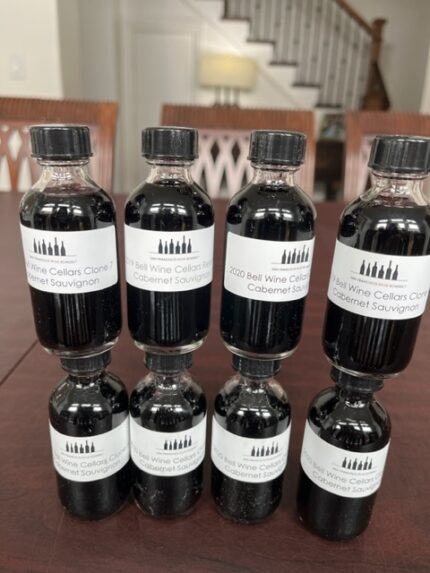I was always aware of the significance of clones in the world of Pinot Noir, but little did I know that Cabernet Sauvignon had a singular tale to tell. This week, I had the unique opportunity to delve into the world of single-clone Cabernets, exploring the balance between nature and nurture in crafting these wines. The University of California, Davis (UC Davis), played a major role in the development of these clones. Its Department of Viticulture and Enology began researching and selecting grapevine clones in the mid-20th century. UC Davis developed the famous Clone 7. At the same time, a few California winemakers realized the possibilities of importing Cabernet Sauvignon clones from Bordeaux, known as the Entav-Inra clones.
The San Francisco Wine School hosted an “Attack of the Clones” session where I had a chance to taste with John Hazak, the winemaker and general manager, and Hillary Cole, the director of sales from Bell Wine Cellars.
Bell Wine Cellars is known for having the largest portfolio of single clones in California. The story of Cabernet clones began with Anthony Bell, a visionary winemaker and founder of the winery, when he joined Beaulieu Vineyard (BV) in Napa Valley in the 1970s. This is where he sparked his interest in studying and selecting grape clones that would match different terroirs. His knowledge was expanded when he traveled through France and studied the various Cabernet clones used in Bordeaux blends. In 1991, he opened Bell Wine Cellars and started experimenting with these clones, putting them in purposeful vineyard sites.
The genetic fingerprint of where these vines are planted, along with the terroir, really makes a difference in what you taste in your glass. These clones bring differences in flavors, terroir, and ripening patterns. You can see some similarities, but there are so many differences.
They told us to think of an orchestra with many different instruments as single clone cabernets. “We wanted to take the best of what we learned and show a clone at its best and purest expression.”
The crazy thing is that it’s the same DNA put into different environments. Like how a child is nurtured and loved, the response in the vineyard can be drastically different. And that can change year over year.

We tried 7 different single clones and one blend.
• 2019 Bell Wine Cellars Cabernet Sauvignon Rutherford “Clone 4” – known for its small berries, rich flavors, elegant tannins, structure, and adaptability. Originally from Mendoza, this is the oldest vineyard planted in the early 90s. I tasted notes of currant, black cherry, cassis, chocolate, and spice.
• 2020 Bell Wine Cellars Napa Valley Cabernet Sauvignon “Clone 7” – known as the Concannon or Wente clone. Characteristics include medium size berries and tannic structure. This clone is in wide use by wineries and vineyards. I tasted blackberry, currant, herbs, tobacco, herbs, and a few green notes.
• 2020 Bell Wine Cellars Cabernet Sauvignon Mt. Veeder “Clone 169” – known for its AVA as well as small clusters with thick skins, it has texture, balanced tannins, and is known for its adaptability. I tasted blackberry, currant, cedar, herbs, and spice.
• 2020 Bell Wine Cellars Cabernet Sauvignon Mt. Veeder “Clone 191” – From the Mt. Veeder AVA, this wine is aged for 22 months in French oak barrels. It is full-bodied with notes of blackberry, black currant, cassis, herbs, and spice.
• 2020 Bell Wine Cellars Cabernet Sauvignon Rutherford “Clone 337”– This is one of the newer clones from France, but it has become known for its small berries, its resistance to weather, and is good for aging. I was surprised by the floral aromas along with the notes of cedar, black fruit, tobacco, and leather.
• 2020 Bell Wine Cellars Cabernet Sauvignon Rutherford “Clone 338″ – John described this one as “screaming Rutherford heritage.” It was full-bodied, had nice tannins, and is known for its concentration. I tasted notes of black fruit, bay leaf, dried herbs, and spice.
• 2019 Bell Wine Cellars Cabernet Sauvignon Napa Valley “Clone 6”– this was Anthony Bell’s favorite clone and Bell Wine Cellars is known for its work here. Thick skins and smaller berries are characteristic of this clone. Known as the Jackson clone, it was established when nineteenth-century imports from an abandoned vineyard were brought into California from Bordeaux. Sadly, there is becoming less of this great clone to be found. I tasted black fruit, spice, herbs, tobacco, and cedar.
• 2019 Bell Wine Cellars Cabernet Sauvignon Napa Valley “Reserve” – taking the specific characteristics and personality from each clone, soil and microclimate coming from a blend of vineyards located in the St. Helena, Rutherford, Mount Veeder, Yountville, and Howell Mountain appellations. This wine was comprised of Clones 7, 269, 337, 338 and 191.
John’s pursuit of the perfect Cabernet single clone has evolved over the past 20 years. It included trials by site to make sure the right clone was matched with the right barrels to continue to unveil the singular splendor of these wines.



